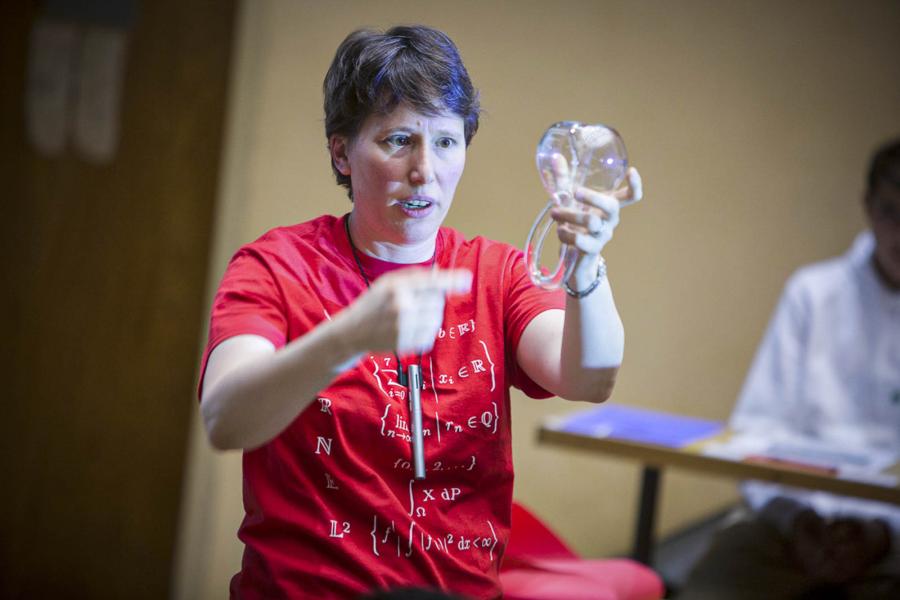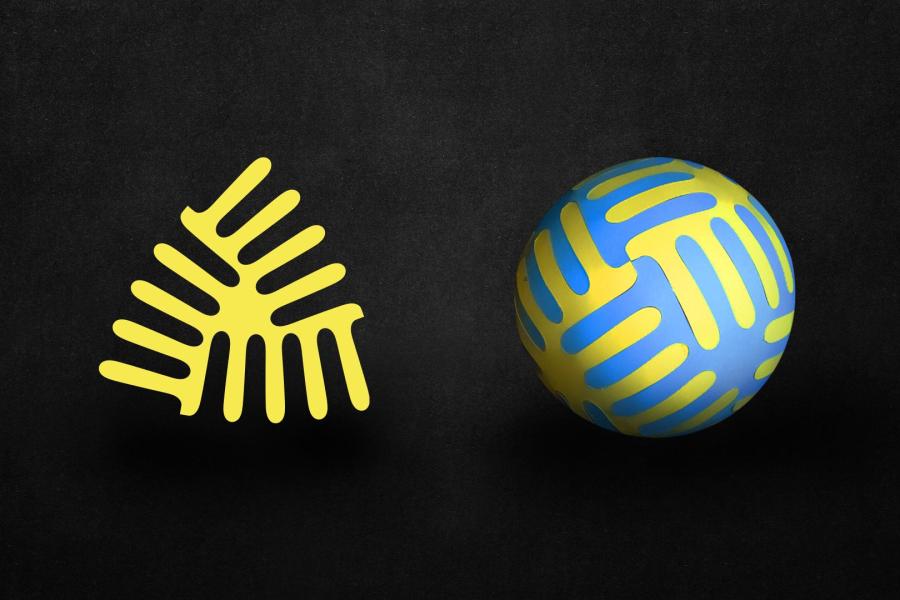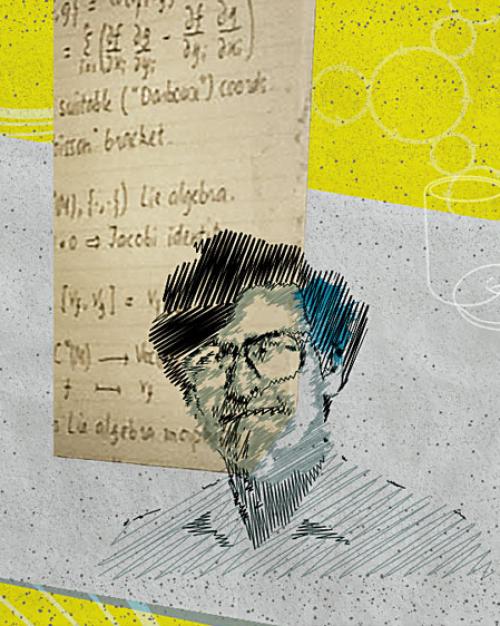Imagine a coffee mug and a cinnamon donut on the table before you. They appear as completely different objects -- but to a mathematician, the mug and the donut are topologically equivalent, “homeomorphic,” because (at least conceptually) you can bend and mold one shape into the other without cutting, tearing, passing it through itself or glueing.
Topologists study geometric objects and how they hold up when deformed by stretching, twisting or bending. They explore how these objects fit together, how you can reshape them and what you can do with them in any number of dimensions.
“Cornell has had a considerable impact across many subfields of topology and across decades, reflecting and at times directing the mainstream of the subject,” says Martin Bridson M.A. ’89, Ph.D. ’91, the Whitehead Professor of Pure Mathematics at the University of Oxford and the president of the Clay Mathematics Institute.

While Cornell mathematicians mostly study the theoretical basis of the field, topology has real implications in the world. For example, topological techniques can be brought to bear on calculating the trajectories of spacecraft, and missions have been saved by the efforts of topologists, notes Tara Holm, professor and chair of mathematics in the College of Arts and Sciences (A&S). Japan’s “Celestial Maiden” (Hiten) is a classic example: the mission was salvaged when a recalculated trajectory allowed it to enter lunar orbit.
“Topology is important for humanity,” says Holm. “The Hiten example shows the importance of basic research because we don't know where it's going to go, and we don't know what we're going to need as humanity. The parts of topology that seem very theoretical, and seemingly have no applications, are suddenly what we're using to secure credit card transactions every time we pay for something on our phone. It's fundamentally important to have mathematicians and other scientists just doing basic research.”
In more mundane ways, we apply topological principles every time we fold clothes, tie a knot or arrange furniture in a room. Navigating a map, too, draws on aspects of topology.

One of Cornell’s ongoing impacts on the field of topology is thanks to Allen Hatcher, professor emeritus of mathematics, who wrote “Algebraic Topology,” published in 2002 by Cambridge University Press.
The textbook is “a global classic” says Bridson. “It is the source from which the majority of students worldwide have learned the subject in the last 25 years, having a huge influence by promoting an approach to the subject that emphasizes geometric intuition.”
Another Cornell milestone in the field of topology is Macaulay2, a computer program that has helped transform the understanding and use of polynomial equations by algebraic geometers all over the world. Written by Michael Stillman, professor of math (A&S) and Stephen H. Weiss Presidential Fellow, and Dan Grayson, the program has demonstrated that mathematical abstractions aren’t so complex that they can’t be computed.
Stillman and his co-author made the program open source, which allows other mathematicians to apply their own research to it. Users have developed more than 300 application packages that are distributed free with the Macaulay2 system; more than 3,800 research publications refer to Macaulay2.
Stillman, whose own work includes a project on string theory in collaboration with physics professor Liam McAllister, has won several awards for Macaulay2, including the Jenks Prize.

Topology at Cornell
Cornell’s involvement with topology began before World War II, and has included numerous luminaries in the field, such as Kenneth Brown, professor emeritus of mathematics (A&S).
“Ken Brown is respected worldwide for his clarity of exposition as well as his theorems -- his name is held in esteem by every topologist from my age down, who all learned cohomology of groups from him, in person or through his wonderful and authoritative book,” Bridson says.
The greatest figure in 3-dimensional topology in the second half of the Twentieth Century was the late William P. Thurston, Jacob Gould Schurman Professor of Mathematics (A&S) and winner of the Fields Medal for revolutionizing the study of topology. Although he came to Cornell late in his career, “he was still an iconic and influential figure, and the fact that he was based in Cornell for a considerable number of years is an important statement on the strength of Cornell topology,” says Bridson.
Geometric group theory emerged as an area of specialized interest in the late 1980s and Cornell, says Bridson, was one of the great hubs of the subject globally, with a string of important figures spending time there, including Karen Vogtmann, Goldwin Smith Professor Emerita of Mathematics (A&S).
The study of topology has grown so big that it could be considered its own discipline, with subfields within it like algebraic topology and geometric topology. But all these areas interact, says Mann, “and we've made a conscious decision at Cornell to continue to capture that breadth in our department,” says Kathryn Mann, associate professor of mathematics and Joyce A. Yelencsics ‘65 & Frederick M. Rosevear ‘64 Faculty Leadership Fellow (A&S).
That breadth is reflected both in the number of faculty working in topology, including two recent new hires, and those like Yuri Berest, whose work encompasses multiple areas of topology.
Topology Festival

One of Cornell’s most far-reaching and long-lasting influences on topology is its annual Topology Festival. For 62 straight years, topologists have gathered from all over the world on the Cornell campus for the renowned conference. It was one of the first – if not the very first – regional conference on the topic and was likely the first big gathering supported by a National Sciences Foundation grant.
“The Topology Festival is a unique event that is cherished by topologists across the world,” says Bridson. “It has made Cornell a constant feature in the life of the field; its evolution faithfully reflects what the most exciting trends have been across the field through the decades that it has existed; and it plays an important role in promoting a sense of community and commonality across generations and across subfields of topology,” says Bridson.
The festival has put Cornell on the map as a destination for topologists and a place to send talented undergraduates for graduate study, says Holm. That’s contributed to Cornell’s historically strong topology group, which continues to attract very strong graduate students and postdocs.
“Topology used to be a more narrowly defined thing but it has blossomed into this rich tree of sub areas that often don't talk to each other. There are not a lot of conferences where they do talk to each other, and even fewer where this happens successfully,” says Mann. “There is a tradition and a real effort to make (the Topology Festival) a ‘what is happening in topology now’ type of conference. And people come because they know this history and they know it works.”
For mathematicians, says Holm, “what really matters is being able to talk to people about your ideas and hear their ideas. And so just the fact that there is this annual meeting where lots of external people are passing through Cornell adds a great vitality to topology life in the department.”
The cross-fertilization of ideas doesn’t happen just at the Topology Festival, but continues through the year via the department’s seminar series which brings eight or nine topologists from outside Cornell to speak every semester in topology. With dozens of seminars on other topics, there are ample opportunities for Cornell topologists to expand their knowledge and consider ideas outside their immediate specialty. That breadth, says Holm, contributes to the ability of Cornell mathematicians to collaborate across disciplines and subfields.
“The math department is a really unique working environment,” says Mann. “More than most other schools that I've spent time at, people talk to each other across areas. They’re not just like mathematical tourists, they have a real interest because they see connections between areas. And that's really special.”
Topology Models

Because they’re working with shapes, topologists get to have fun with real-world objects as models. Kelly Delp, senior lecturer of mathematics in the College of Arts & Sciences, explores how to make well-fitting clothing using mathematical principles.
“Making garment patterns is fundamentally a question about geometry: how do we make a pattern out of flat fabric that will fit our 3-dimensional bodies which have variable curvature?” she says. Her project was inspired by a design workshop held in 2010 taught by Thurston, along with Susan Ashdown, emerita professor of human centered design in the College of Human Ecology.
After the workshop, Delp and Thurston worked together building surfaces from flat, rigid materials; Delp continued exploring the topic after Thurston’s passing, including a recent collaboration with an apparel design graduate student.
Thurston inspired another mathematician at Cornell, Daina Taimina, retired adjunct professor of mathematics, to explore tactile ways to express topological ideas. She wanted a tangible way to describe one of the hardest-to-describe concepts in geometry: the hyperbolic plane, a two-dimensional surface that curves away from itself (the opposite of a sphere). Taimina did the impossible by devising a way to crochet examples of hyperbolic planes. Her creations have been exhibited at the Smithsonian Museum and dozens of other places, inspired numerous projects and resulted in an award-winning book, "Crocheting Adventures with Hyperbolic Planes."

In a foreword to the book, Thurston wrote: "Many people have an impression that mathematics is an austere and formal subject concerned with complicated and ultimately confusing rules for the manipulation of numbers, symbols, and equations, rather like the preparation of a complicated income tax return. ... Good mathematics is quite opposite to this. Mathematics is an art of human understanding.”
Inna Zakharevich, associate professor of mathematics (A&S), uses 3D printing to create tactile models that demonstrate mathematical principles – including those related to topology -- and which make those principles fun to discover through hands-on exploration for her students.
Her own topological research focuses on K-Theory; the importance of her work has been recognized by the National Science Foundation, from which she received a Faculty Early Career Development Program Award. Problem solving often involves breaking a problem down into smaller sub-problems, solving those smaller equations, then assembling the answers into a solution to the original problem. K-Theory focuses on the multiple ways of glueing the smaller answers back together to arrive at the overall solution.
Geometric topologist Mann’s work is “very spatial and visual,” she says, often on structures on three-dimensional spaces, which also lend themselves to 3 dimensional models. Her current project works with manifolds, which are shapes that, locally, look like a space with consistent dimensions – imagine standing on a sphere and looking around; you’d think you were on a flat surface because all you could see was your local environment. Her work was profiled last year in Quanta Magazine; she has also received a National Science Foundation Faculty Early Career Development Award for her work on manifolds.
Topology Beyond Mathematics
The tools topologists such as those at Cornell develop for use in mathematics are also of wide-ranging use to scientists in other fields.
In chemist Roald Hoffmann’s Nobel Prize-winning work, orbital interaction and symmetry relations between molecules or parts of molecules are fundamental concepts, and those relations are topological.
The concept of topological invariants has been applied in numerous ways as well. One way to understand the concept is through the metaphor of a belt, explains Steve Strogatz, the Susan and Barton Winokur Distinguished Professor for the Public Understanding of Science and Mathematics (A&S). A buckled belt is a ring, but if you put a twist in that belt before you buckle it, there is no way to get rid of that twist short of unbuckling the belt.
“If you try to eliminate one twist, you just create another. It's like a whack-a-mole game. That twist is what topologists mean by an ‘invariant’ – you can’t change it by any continuous action, it’s locked into the belt. DNA is usually in a circular, closed ring just like a belt,” says Strogatz.
This topological feature of DNA is also what enables it to package its enormous length into a cell. “It’s the equivalent of stuffing ten or more miles of string into a tennis ball,” Strogatz says. “The solution that evolution came up with uses this topological conversion of twisting into coiling to make more compact structures.” The concept was the topic of Strogatz’s first published paper in 1981, a collaboration with a molecular biologist that because of Strogatz’s understanding of topology was able to achieve a surprising result.
Michelle Wang, James Gilbert White Distinguished Professor of the Physical Sciences (A&S), is currently studying the molecular mechanics of fundamental biological processes, including DNA topology during transcription and replication. Using optical tools, she can manipulate DNA topologically, putting twists in it, tying knots and seeing how it stretches.
Eun-Ah Kim, professor of physics, has harnessed this feature of topology in the service of quantum computing. By encoding information in a topologically protected way using non-Abelian anyons she and her colleagues have taken a significant step toward creating fault-tolerant quantum computers that have a built-in error correction system.





